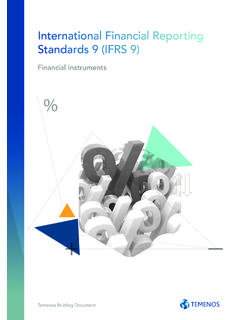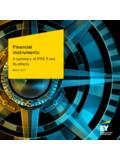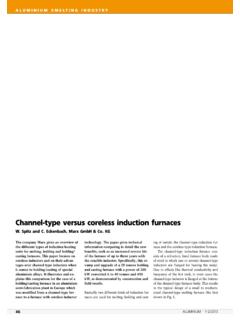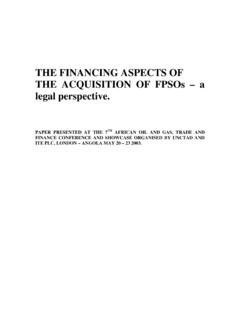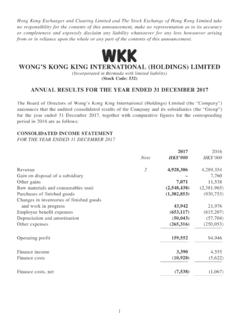Transcription of ey.com/IFRS New proposals for financial …
1 New proposals for financial instruments at amortised 61 / November 2009 Supplement to IFRS outlookThe International Accounting Standards Board (IASB) has reached another key milestone of its comprehensive project to replace IAS 39 financial instruments : Recognition and Measurement the publication of a new Exposure Draft (ED) on financial instruments : amortised Cost and Impairment. The ED will apply to all financial assets and financial liabilities recorded at amortised cost in accordance with the first phases of the financial instruments project - IFRS 9 financial Instruments1.
2 The timeline for the IAS 39 replacement project is shown in Table 1 below. In this publication, we provide an overview of the proposals in the ED and discuss the impact this is likely to have on businesses. Table 1: Timeline for IAS 39 replacement projectSummary of ED proposalsThe ED proposes an impairment methodology, based on expected credit losses and expected cash flows, for all financial assets measured at amortised cost. Since impairment is an integral part of amortised cost measurement, the ED also addresses the calculation of amortised cost and the computation of the effective interest rate, which are largely a restatement of the principles in IAS 39.
3 The guidance on the use of the effective interest rate applies to both financial assets and financial liabilties measured at amortised cost. In addition, a significant section of the ED is dedicated to new disclosure replacement of IAS 39 Request for information: ImpairmentExposure draft: Classification and measurementFinal standard Classification and measurement ( financial assets) Exposure draft: Hedge accountingPossible revised exposure draft: DerecognitionFinal standard: amortised cost and impairmentExposure draft: amortised cost and impairmentFinal standard: Classification and measurement ( financial liabilities)Final standard.
4 Hedge accountingFinal standard: DerecognitionJune 2009 July 2009 Nov 2009 Jan-Mar 2010 Apr-June 2010 July-Dec 20101 The first phase of IFRS 9 financial instruments deals with classification and measurement of financial assets and is available for early adoption for 2009 year end financial statements, but application will not be mandatory before 2013. See Supplement to IFRS outlook Issue 60. A standard on financial liabilities is expected in the first quarter of proposals for financial instruments at amortised costAmortised costAmortised cost is defined in the ED as a cost-based measurement of a financial instrument that uses amortisation to allocate interest revenue or interest expense over the life of the instrument.
5 It is calculated as the present value of expected cash flows discounted at the effective interest rate. Current requirements of IAS 39 Currently, entities take into account estimated cash flows when setting the effective interest rate. Subsequent revisions to estimates do not change the effective interest rate, which is kept constant for a fixed rate instrument. Instead, there is a catch-up adjustment to profit or loss so that the adjusted carrying amount continues to be recorded at the net present value of the remaining expected cash flows, discounted at the original effective interest rate.
6 On the other hand, for a floating rate instrument, the effective interest rate will change to reflect movements in market interest rates. IAS 39 does not require a catch-up adjustment for floating rate instruments solely due to changes in market interest from IAS 39 The ED proposes an effective interest rate calculation similar to IAS 39. For financial assets, the primary difference is that estimates of cash flows in the proposed model are to be made net of expected credit losses (described further, below).
7 While IAS 39 was silent about the reflection of non-performance risk in the determination of expected cash flows for financial liabilities, the ED indicates that non-performance risk shall not be reflected in them. In addition, the ED proposes that the amounts and timing of the cash flows shall be the probability-weighted possible outcomes, rather than the most likely movements in market interest rates result in changes to the effective interest rate for a floating rate instrument, the ED proposes a catch-up adjustment for such instruments when the contractual rate changes.
8 Each expected cash flow is discounted at a rate equal to the sum of the initial effective spread and the zero coupon rate2 (applicable to that cash flow) on the benchmark yield curve3 at the measurement date, in order to determine the adjustment. The initial effective spread is derived from the carrying amount, the expected cash flows and their corresponding benchmark rates at inception, and is kept constant. The requirement to take into account future expected changes in the benchmark rate differs from current requirements and would considerably complicate the accounting for floating rate instruments .
9 2 The zero coupon rate is theoretically the interest rate of a zero coupon bond with the same timing and risk characteristics as the cash The yield curve applicable to the contractual variable rate of the instrument, , if the contractual variable rate of the instrument is LIBOR, the benchmark yield curve would be based on LIBOR. 3 New proposals for financial instruments at amortised costImpairment and the expected cash flow approachIAS 39 currently requires impairment of financial instruments that are recorded at amortised cost to be determined using an incurred loss model, where an impairment loss is only recognised when a loss event has occurred.
10 The ED proposes one impairment model for all financial assets recorded at amortised cost (as determined under IFRS 9) that includes all accounts receivables, based on an expected cash flow approach. In this approach, impairment losses are recognised over the life of the financial asset, by including expected losses in the computation of the effective interest rate when the asset is first recognised. Changes in credit loss expectations are reflected in catch-up adjustments to profit or loss. Table 2 below, highlights the key features of the incurred loss model currently required by IAS 39 and how the proposed expected cash flow approach would differ.











